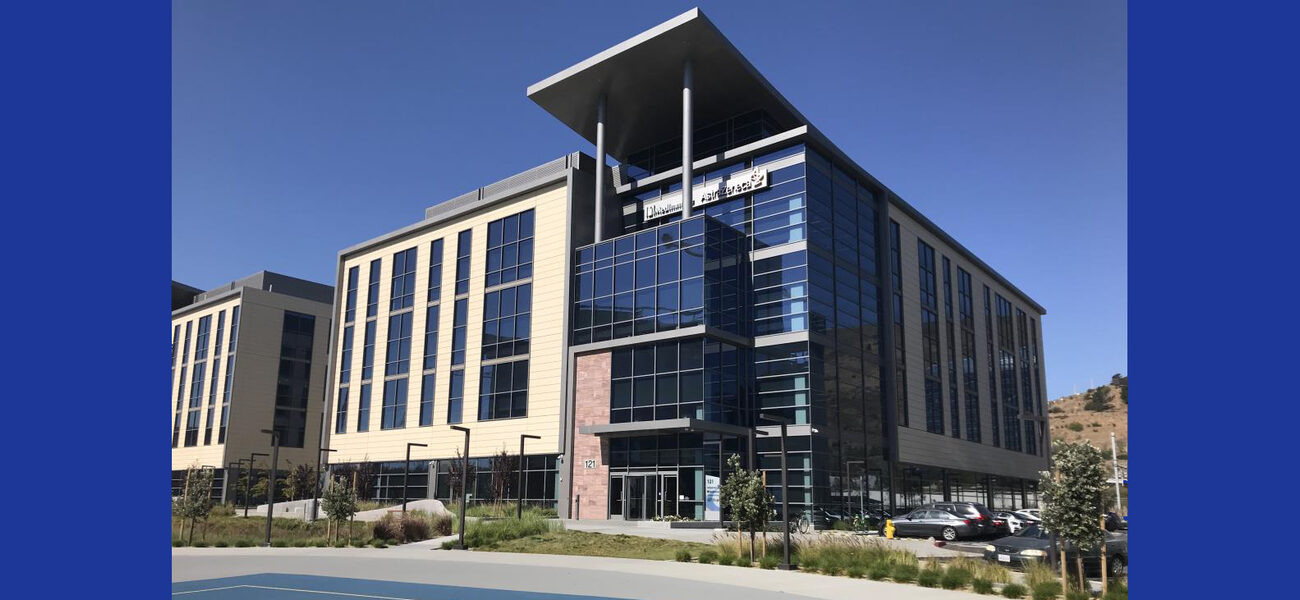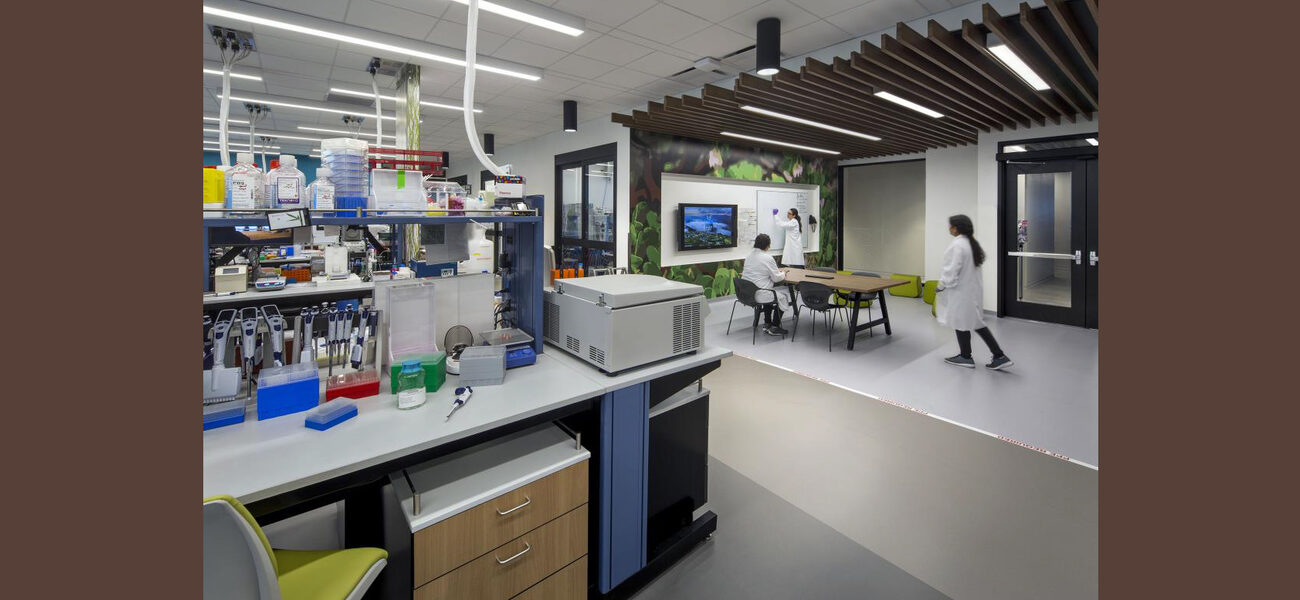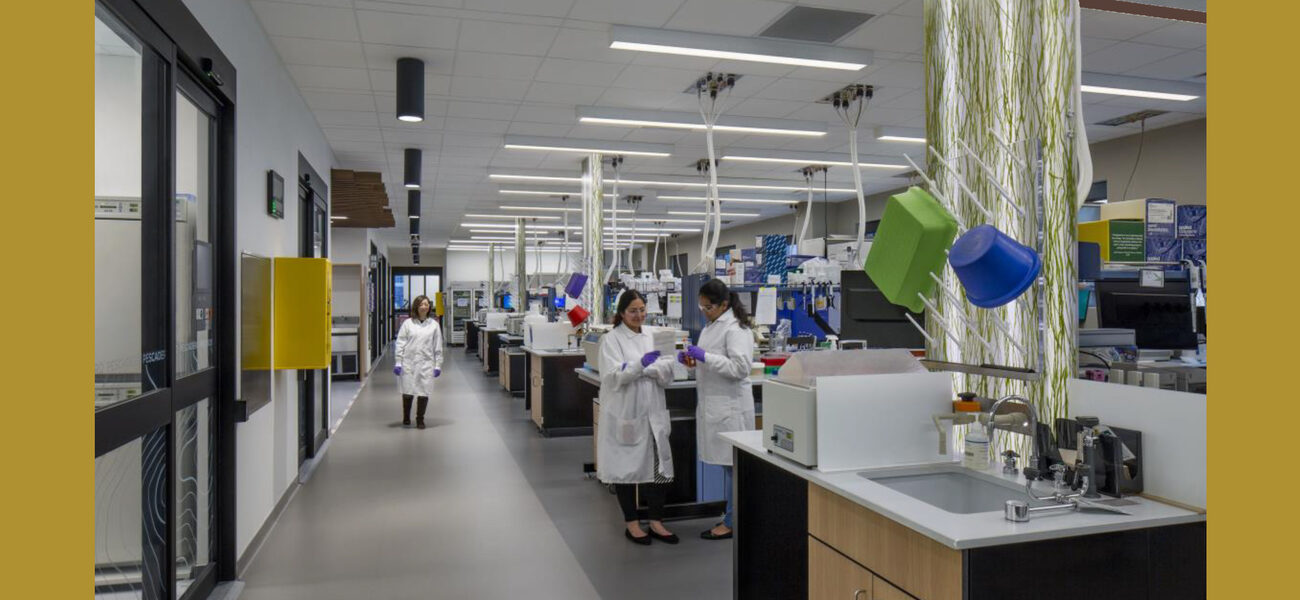The new 100,000-sf AstraZeneca site in South San Francisco, located in the Cove at Oyster Point complex, is the company’s first facility where open offices and labs are seamlessly integrated with each other to promote increased mobility and interaction among the researchers. Housing around 400 employees, the building brings together staff from AstraZeneca’s Technology Innovation & Delivery Excellence (TIDE) unit, as well as subsidiaries MedImmune, Acerta Pharma, and Pearl Therapeutics into one state-of-the-art facility at the center of the Bay Area’s vibrant biotech and technology sector.
The facility is designed around AstraZeneca’s iWork philosophy, an activity-based working approach that embraces industry best practices for employee wellbeing and productivity. It features open collaborative lab and office environments, team rooms, conference rooms, and a wide variety of activity-based workstations with ample natural light that include treadmill-equipped team rooms and other alternatives. Activity-based workspaces give personnel the ability to choose a place in the office that is best suited to doing their specific tasks. Spaces are designed to create opportunities for a variety of activities from focused work to formal and informal meetings.
“We set up activity-based workspaces all around the site to support our open shared seating areas with a variety of options for the many various things employees do throughout the day,” says Martin Sharpless, project director for AstraZeneca at the Oyster Point complex “Every niche was set up with different environments for people to work in, and all of them get used.”
In addition to activity-based workspaces, the building supports the iWork model with adjustable desks and ergo-dynamic chairs, pantries offering organic food options, and an on-campus gym. Other lifestyle amenities include a basketball court, bowling alley, full-service restaurant and bar, and 10 miles of campus-accessible trails.
Move Management
AstraZeneca wanted to bring all five of their Bay area organizations together to collaborate in a single facility. But each group brought their own brand, culture, and background that needed to be accommodated as part of the move to a new location.
“There’s a lot of change involved when you move science from one site to another,” says Paul Long, director of site operations for AstraZeneca. “It’s a big deal to uproot what you’ve been doing and move into a new facility. And each one of these groups had a different environment that they were coming from. Some were already in an open work environment, others were more traditional, so it was really important for the staff to have buy-in and a sense of ownership in their new space.”
To help staff from the different units understand and support transitioning to the new facility, the company took the design concepts on a road show presentation to each of the existing facilities. One of the main elements of the presentation was a virtual reality 3D model of the entire facility that people could “walk” through using a VR headset.
“The virtual reality element was important for us,” says Sharpless. “We added some cost to the original HOK proposal on the order of $40,000 for the VR modeling and production time, taking the Revit documents to the VR level of rendering. This allowed people to not only see it visually, but also walk through it virtually. Another important thing was that we didn’t leave this presentation to the architects or builders or anyone else to explain. It was our stuff for our people. And I think that made a big difference to folks.”
The team explained the value of activity-based workstations, organic pantries, and lifestyle amenities. Employees also got to choose things like their preferred ergonomic chairs and the type of headset they wanted.
“Being able to select a headset for your phone was kind of a big deal, because we transferred from a facility where everybody had a phone at their desk to a space where your computer was your phone,” says Long. “So, we gave them five choices, all the way from noise-cancelling headsets to earbuds.”
“Our move management process was simple, but it was also crucial,” says Sharpless. “We prepared well in advance and implemented it with knowledgeable folks who understand the transition requirements for science.”
Open Flexible Design and Shared Facilities
One of the main goals of the project was to provide shared resources and a flexible, open design across all areas of the facility that all employees could access. The site was designed knowing that about 400 people would move into it initially and that the population could eventually grow to 650. Neighborhood zones were designed to evolve from assigned seating to shared seating that accommodates about 24-30 people each, with the ability to grow to 50 people per neighborhood in the future. The layout also provides a two- to four-person team room for every 10 people. While there are a few secure labs and doors by necessity, the entire building is open and accessible to the campus population.
“Slider doors were installed between the labs,” says Sharpless. “It turns out they are liked, but they aren’t really needed for separation except in spaces like the tissue culture room, the virology lab, and of course the darkroom. A key benefit has been the avoidance of cross-contamination due to the use of hand-wave sensors, which eliminates the touching of doorknobs. We also eliminated the door swing zones which mitigates the safety hazard of door swinging and allows for the optimum use of space for laboratory equipment.
“There were five different business units moving into the same group,” he says, “so we took a strong approach towards integration and organized the labs close to the open offices and provided shared services via a single facility operator. We found that when you bring people from different business units together and condense them into a new space, sharing becomes a natural solution to a lot of the challenges. The key with lab space is that, when facilities are shared, not everyone needs a storeroom or a microscope.”
The majority of AstraZeneca’s research and development operations are located in Gaithersburg, Md., and Cambridge, UK. In order to foster collaboration across the organization, Microsoft® conferencing hubs were installed on the wall that allow researchers to participate in whiteboard sessions and conference calls directly from the lab.
“The tools are available for them to sit down and review data together or talk with their colleagues at another site,” says Long. “If we have a large company-wide meeting or town hall, there may be people who still need to work in the lab while that’s happening. We can stream the content to their conference screens in the lab, so those people can still hear and see what’s going on in the presentation.”
Flexibility was also a key design feature. Ceiling service panels over each laboratory workstation provide easy modular access to power and gases.
“You really can’t provide too much flexibility in your lab and office workspaces—whether it’s physical flexibility, technology flexibility, or building systems,” says Sharpless. “You should build in as much flexibility as you can afford to in a reasonable manner and keep it simple where you have the choice, but it’s important to have that flexibility.”
“We really wanted to be able to maintain this facility while keeping science moving all the time,” says Long. “If we need a change in the labs, or we need to do some maintenance, we can do it from the ground level. Wall-mounted shut-offs are located throughout the facility, so we don’t have to pop tiles. If I need to do a small segment of work, I can isolate that area from the ground. We don’t have to interrupt operations. This means that I can turn a science experiment around in a few days. Instead of needing to get contractors to run piping or electrical, it’s all there and ready to go. They moved the equipment in on move day and three days later, science was back up and running because of all the service panels and preplanning.”
Environmental Sustainability
Another important goal with the facility was achieving a high level of environmental sustainability. As a result, a number of design elements went into the building that helped it receive a LEED platinum score, which is traditionally difficult for laboratories to achieve. Because the building is located in South San Francisco, it can operate with 100 percent renewable energy as part of the ECO100 program offered by local power provider, Peninsula Clean Energy (PCE). In addition to utilizing reusable and low-VOC building materials, the carpet squares were made from bags harvested from the ocean and recycled into carpet.
“We did a lot of things that were above and beyond to make sure we provide an environment for our employees that tells a story of sustainability,” says Long. “The site is now on the journey to being a zero-waste site, including the laboratories, and the building is so energy efficient that it can run on the backup generator for up to seven days.”
“Everyone talks about the cost of sustainability,” says Sharpless. “But the cost was not outrageously different for the efficient systems that we put in, especially since we started with California standards. The energy savings alone will rapidly pay for it.”
By Johnathon Allen
| Organization | Project Role |
|---|---|
|
HOK Science + Technology Group
|
Architect
|


